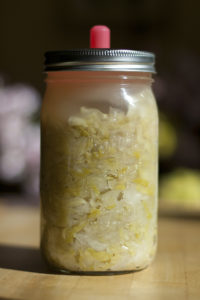One of the first vegetables I tried fermenting was cabbage to make traditional sauerkraut. I had long heard that this was a great beginner step and nearly impossible to screw up.
No special equipment is necessary for fermentation, but after struggling to keep thinly sliced jalapeños and cucumber submerged under the brine, I invested in Masontops Complete Fermentation Kit. I got the one that fits wide mouth mason jars. The kit comes with weights, pickle pipe lids (that release gas pressure so you don’t need to burp your ferments), a wooden pickle packer, and a small booklet with fermentation instructions.
Fermenting traditional sauerkraut was my first experiment with this kit. Although it was easy and the first batch turned out alright, I still managed to make some beginner mistakes I point out for you to avoid in the notes below.
Fermenting Traditional Sauerkraut at Home

What You Will Need:
- a quart sized mason jar
- some sort of weight to keep cabbage under brine
- a lid
- 2lb cabbage (A small cabbage is about 2 lbs. You want the freshest you can find. I used a organic green one from the grocery store for my first batch.)
- 1 tbsp fine salt (I used pink Himalayan salt. You want a salt free of additives like iodine and anti caking agents)
- 1 tsp whole spices (I used dill seeds. Caraway or celery seeds are good options too.)
How to Ferment:
I rinse my cabbage and remove any spotted leaves. Then I peel off one whole leaf and set it aside for later use. I cut the cabbage into quarters and remove the cores. Next I shred the cabbage by cutting across the grain as thinly as I can.
As I place each shredded quarter into a large bowl, I sprinkle some of the salt over it. I layer cabbage and salt into the bowl until I am out of both. Then I sprinkle on my dill seed.
I toss the cabbage in the bowl with a wooden spoon until the salt and dill seed are evenly mixed. You could use your hands but I found the salt and seeds stuck to mine more than the cabbage.
Once it’s mixed well, I use the pickle packer to pound the cabbage so it breaks down and releases its water content to make the brine. I pound the cabbage into the bowl until it’s flat and then mix it up and do it again. If you don’t have a pickle packer, you could use a potato masher or back of a wooden spoon. You can also put a heavy plate on top of the cabbage and leave it covered in the bowl for a couple of hours until enough liquid has been released to make the brine.
After 10 to 15 minutes of pounding the cabbage and making it wilted and juicy, I begin to pack it into the jar. I add a couple of handfuls of cabbage and then push it down with the other end of the pickle packer. Again a wooden spoon could likely work too.
I fill the jar to the shoulder. So far 2 lbs of cabbage has fit nicely into a quart sized mason jar.
Once it’s packed in the jar, I take the whole cabbage leaf from earlier and carefully tear it into the size of the mason jar. Then I fit it into the jar over the top of the shredded cabbage. This will help keep small pieces from floating up. I put one of the weights on top of the leaf.
Next I add any leftover brine to the jar so that the weight is fully submerged in liquid. (I learned this the hard way with my first batch – see notes below).
Then I top it with the pickle pipe lid and screw on my canning ring to hold it in place. I pinch the pipe top to make sure it can open to let gases out.
Further care:
I keep my ferment on the counter out of the sun sitting in a bowl in case any juices build up and leak. That way I also remember to check it every couple of days to make sure my brine level stays up and there’s nothing growing on the surface.
I make sure to label the jar with the date started or put a note into my phone so I can keep track of how long it has been fermenting.
Sauerkraut takes 3 weeks to a month to ferment depending on the temperature of the environment. When you think it is ready, try a taste. The salty flavor should be replaced by a nice tang and the cabbage will be nearly translucent. When you are happy with the flavor, take out the weight, cap it with its original lid and store it in the fridge.
I like to make small batches so I can keep experimenting with different flavors. We usually eat our within a few weeks but it will stay fresh in the fridge for many months.
Notes:
I didn’t check my first batch of sauerkraut often enough. The weight wasn’t submerged under the brine. Kahm yeast developed on top. I scraped it away as best I could but it kept coming back. The yeast doesn’t make it inedible but it doesn’t smell very pleasant either.
I wound up ending the ferment a little early, scraping off the top layer of sauerkraut to be safe. The rest was tasty and I learned my lesson. Now I open up the ferment to check the top of it every few days.
With my second batch, there was plenty of brine to keep the weight covered and then a few days into it, my sauerkraut was suddenly totally dry, like the liquid had evaporated overnight. I simply made more brine – 1/2 teaspoon salt dissolved in 1/2 cup filtered water – adding it until the weight was covered again. It turned out fine.
We enjoy our sauerkraut as an addition to sandwiches or as a side dish with meals. Sometimes I’ll have a little bit during the day for a tangy probiotic snack.
Other Fermentation Experiments:
- I make homemade yogurt every other week.
- Before summer I started a ginger bug and used it to make several batches of ginger beer.
- Water kefir has been a big hit for us. I keep continuous batches going. It’s refreshing after the first ferment but I also enjoy flavoring and carbonating it in a second ferment. I prefer the sweetness of this over the more popular kombucha.
Further Resources:
The Art of Fermentation by Sandor Ellix Katz
Masontops Complete Fermentation Kit and website
Have you tried incorporating fermented foods into your diet?


